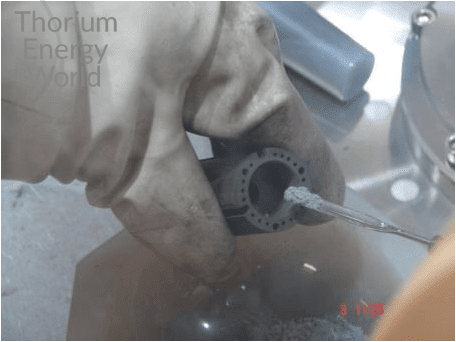
In the midst of depressing news about the United States pulling out of the Paris Climate Accord and the nuclear renaissance that always seems to be just around the next corner, comes some good news from Europe on the future of clean energy. Scientists at the Nuclear Research and Consultancy Group (NRG) in Petten, Netherlands, have begun the world’s first thorium molten salt reactor experiment in over 45 years. “There are only a few places in the world where these tests can be done. With this, Europe has entered the Thorium Energy race.” says Andreas Norlin from ThoriumEnergyWorld.com.
“This is a technology with much perspective for large scale energy production… We see this as a commercial opportunity for the long-term.”
Sander de Groot, reactor core expert at the NRG
The first phase of SALIENT will focus on creating cleaner reactor fuel. This is achieved by removing the noble metals from the thorium fuel as it transmutes to uranium and undergoes fission. In the second phase, researchers hope to test the resilience of commonplace materials that go into the construction of Thorium Molten Salt Reactors (TMSR). If they are found to be sufficient against corrosion and high temperature, it could drastically reduce costs of nuclear power. Future phases are expected to test new or special materials that have shown greatest promise similar experiments in the past, such as hastelloy, an alloy of nickel, and TZM – a titanium-zirconium-molybdenum alloy.
Promising results at Petten would take the world one step closer to achieving the commercial mainstreaming of thorium molten salt reactors. These reactors are significantly safer than the most advanced present reactors in terms of safety and nuclear weapons proliferation risk as well as much simpler in design, making them faster to construct and therefore cheaper. TMSRs also virtually eliminate the problem of long-lasting nuclear waste. The exponentially more efficient technology generates only a fraction of the waste of a conventional reactor with none of the persistent radioactive substances. This makes waste storage and disposal much more manageable.
Highly scalable, TMSRs are candidates for deployment near small towns as well as big cities. This greater area of application allows more people to come under the cover of green energy and is an important environmental development. Most conveniently, TMSRs can operate around the clock and are thus a most reliable source of electricity. Even fueling can be done continuously and shutting a reactor down would be necessary only for periodic maintenance at intervals of perhaps several years.
Presently, only China, India and Indonesia are working on TMSRs. China’s approach involves an intermediate step of operating a molten salt cooled pebble bed reactor, and Indonesia has expressed interest in working with ThorCon to test a full-scale unfueled reactor before beginning commercial operations. India has a couple of TMSR designs on the drawing board but neither have received much attention as its scientists are proceeding with their thorium-fueled Advanced Heavy Water Reactor and the PM is occupied securing contracts on LWRs from Russia.
NRG’s venture with SALIENT also increases competition in the international system to win the honor of being the first to bring a commercial thorium-fueled reactor online. From a traditional perspective, greater competition and more innovative ways of solving a problem brings about superior efficiencies and solutions. The experiment at NRG has the additional benefit of potentially putting Europe in the lead in the quest for commercial thorium energy after decades of lagging behind. Success at Petten might push countries like India to develop their technology faster; it may also give impetus to American startups, who have had some interesting ideas but struggle without the required funding and legislation to make them serious projects. ?
“It will be very interesting to see how this develops and how it might change things for existing and potential players” said Andreas Norlin from ThoriumEnergyWorld.com
?
If the experiments in Netherlands prove successful, most importantly, they will bring the world a vital step closer to clean and abundant energy that can be build anywhere in the world, is available around the clock and is independent of the weather. ?
Learn more: World’s first thorium molten salt experiment in over 45 years
The Latest on: Thorium molten salt reactors
[google_news title=”” keyword=”thorium molten salt reactors” num_posts=”10″ blurb_length=”0″ show_thumb=”left”]- molten salton April 25, 2024 at 5:00 pm
China is starting the operation of its 2 megawatt molten salt prototype reactor in 2024. They are progressively scaling up to 10 MW reactors, 100 MW and then a 168 MWe modular reactor around 2030. The ...
- Molten Salt Reactor Technology Solves Several Nuclear Industry Problemson April 9, 2024 at 1:36 am
MSRs offer several potential advantages, including enhanced safety, reduced waste generation, and the ability to utilize thorium as a fuel source, as previously mentioned. “There are several molten ...
- Molten Salt Reactor Technology Solves Several Nuclear Industry Problemson April 8, 2024 at 10:36 pm
The U.S. Senate on April 30 passed—by unanimous consent—a bill to ban imports of unirradiated low-enriched uranium (LEU) produced in Russia. The bill now heads to the president’s desk for ...
- Molten Salt Reactor Technology Solves Several Nuclear Industry Problemson April 8, 2024 at 5:00 pm
And the big thing is, whether you’re fueling a molten salt reactor with uranium or thorium or plutonium or whatever, it’s a far superior reactor technology. It absolutely cannot melt down ...
- ORNL molten salt concept could lead to 'smartphone' of reactorson October 2, 2023 at 10:35 am
Weinberg long promoted the ORNL-designed molten salt reactor experiment (MSRE) based on Glenn Seaborg’s 1942 discovery using a cyclotron that bombarding thorium with neutrons that eventually yields ...
- The Integral Molten Salt Reactor And The Benefits Of Having A Liquid Fission Reactoron June 7, 2023 at 2:23 am
So too for molten salt reactors (MSRs), which saw Oak Ridge National ... being used to breed fuel from fertile fission products or thorium salts – with the graphite moderator moderating all ...
via Google News and Bing News









